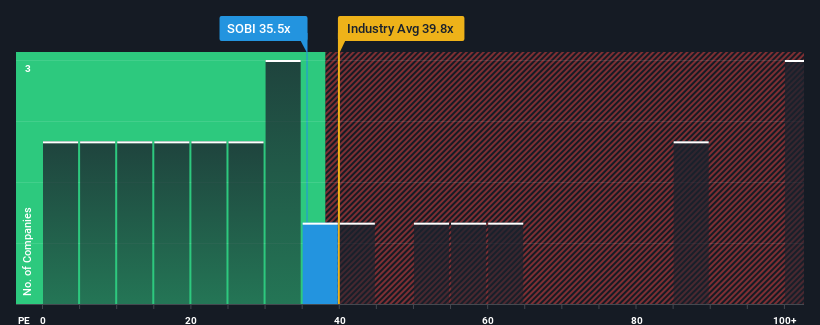Swedish Orphan Biovitrum AB (publ)'s (STO:SOBI) Earnings Haven't Escaped The Attention Of Investors

When close to half the companies in Sweden have price-to-earnings ratios (or "P/E's") below 22x, you may consider Swedish Orphan Biovitrum AB (publ) (STO:SOBI) as a stock to avoid entirely with its 35.5x P/E ratio. Nonetheless, we'd need to dig a little deeper to determine if there is a rational basis for the highly elevated P/E.
There hasn't been much to differentiate Swedish Orphan Biovitrum's and the market's earnings growth lately. It might be that many expect the mediocre earnings performance to strengthen positively, which has kept the P/E from falling. You'd really hope so, otherwise you're paying a pretty hefty price for no particular reason.
View our latest analysis for Swedish Orphan Biovitrum

Does Growth Match The High P/E?
In order to justify its P/E ratio, Swedish Orphan Biovitrum would need to produce outstanding growth well in excess of the market.
If we review the last year of earnings growth, the company posted a worthy increase of 6.5%. Still, lamentably EPS has fallen 23% in aggregate from three years ago, which is disappointing. Therefore, it's fair to say the earnings growth recently has been undesirable for the company.
Looking ahead now, EPS is anticipated to climb by 24% per year during the coming three years according to the eleven analysts following the company. With the market only predicted to deliver 14% per year, the company is positioned for a stronger earnings result.
In light of this, it's understandable that Swedish Orphan Biovitrum's P/E sits above the majority of other companies. It seems most investors are expecting this strong future growth and are willing to pay more for the stock.
The Key Takeaway
While the price-to-earnings ratio shouldn't be the defining factor in whether you buy a stock or not, it's quite a capable barometer of earnings expectations.
We've established that Swedish Orphan Biovitrum maintains its high P/E on the strength of its forecast growth being higher than the wider market, as expected. Right now shareholders are comfortable with the P/E as they are quite confident future earnings aren't under threat. It's hard to see the share price falling strongly in the near future under these circumstances.
We don't want to rain on the parade too much, but we did also find 3 warning signs for Swedish Orphan Biovitrum that you need to be mindful of.
You might be able to find a better investment than Swedish Orphan Biovitrum. If you want a selection of possible candidates, check out this free list of interesting companies that trade on a low P/E (but have proven they can grow earnings).
New: Manage All Your Stock Portfolios in One Place
We've created the ultimate portfolio companion for stock investors, and it's free.
• Connect an unlimited number of Portfolios and see your total in one currency
• Be alerted to new Warning Signs or Risks via email or mobile
• Track the Fair Value of your stocks
Have feedback on this article? Concerned about the content? Get in touch with us directly. Alternatively, email editorial-team (at) simplywallst.com.
This article by Simply Wall St is general in nature. We provide commentary based on historical data and analyst forecasts only using an unbiased methodology and our articles are not intended to be financial advice. It does not constitute a recommendation to buy or sell any stock, and does not take account of your objectives, or your financial situation. We aim to bring you long-term focused analysis driven by fundamental data. Note that our analysis may not factor in the latest price-sensitive company announcements or qualitative material. Simply Wall St has no position in any stocks mentioned.
About OM:SOBI
Swedish Orphan Biovitrum
An integrated biotechnology company, researches, develops, manufactures, and sells pharmaceuticals in the therapeutic areas of haematology, immunology, and specialty care in Europe, North America, the Middle East, Asia, and Australia.
Good value with proven track record.


